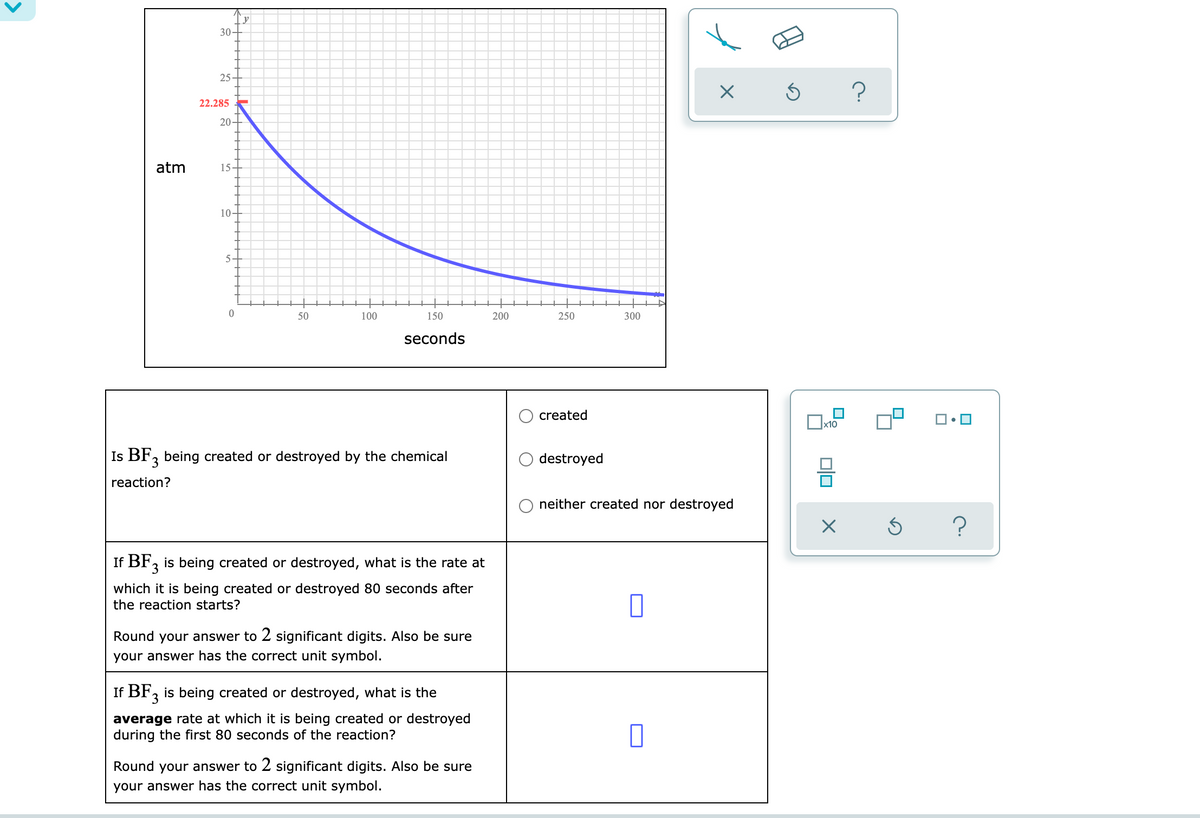30- 25 22.285 20- atm 15 10- 5- 50 100 150 200 250 300 seconds created Is BF, being created or destroyed by the chemical O destroyed reaction? O neither created nor destroyed If BF, is being created or destroyed, what is the rate at which it is being created or destroyed 80 seconds after the reaction starts? Round your answer to 2 significant digits. Also be sure your answer has the correct unit symbol.
30- 25 22.285 20- atm 15 10- 5- 50 100 150 200 250 300 seconds created Is BF, being created or destroyed by the chemical O destroyed reaction? O neither created nor destroyed If BF, is being created or destroyed, what is the rate at which it is being created or destroyed 80 seconds after the reaction starts? Round your answer to 2 significant digits. Also be sure your answer has the correct unit symbol.
Chemistry: Principles and Reactions
8th Edition
ISBN:9781305079373
Author:William L. Masterton, Cecile N. Hurley
Publisher:William L. Masterton, Cecile N. Hurley
Chapter11: Rate Of Reaction
Section: Chapter Questions
Problem 71QAP: For a certain reaction, Ea is 135 kJ and H=45 kJ. In the presence of a catalyst, the activation...
Related questions
Question

Transcribed Image Text:30-
25
22.285
20
atm
15.
10-
50
100
150
200
250
300
seconds
created
x10
Is BF, being created or destroyed by the chemical
3
destroyed
reaction?
neither created nor destroyed
is being created or destroyed, what is the rate at
If BF3
which it is being created or destroyed 80 seconds after
the reaction starts?
Round your answer to 2 significant digits. Also be sure
your answer has the correct unit symbol.
If BF, is being created or destroyed, what is the
3
average rate at which it is being created or destroyed
during the first 80 seconds of the reaction?
Round your answer to 2 significant digits. Also be sure
your answer has the correct unit symbol.
Expert Solution
Step 1
The ideal gas law suggest that The volume is directly proportional to the number of moles of the gas, absolute temperature and inversely proportional to the pressure.
Step by step
Solved in 3 steps

Knowledge Booster
Learn more about
Need a deep-dive on the concept behind this application? Look no further. Learn more about this topic, chemistry and related others by exploring similar questions and additional content below.Recommended textbooks for you

Chemistry: Principles and Reactions
Chemistry
ISBN:
9781305079373
Author:
William L. Masterton, Cecile N. Hurley
Publisher:
Cengage Learning

Chemistry: The Molecular Science
Chemistry
ISBN:
9781285199047
Author:
John W. Moore, Conrad L. Stanitski
Publisher:
Cengage Learning

Chemistry for Engineering Students
Chemistry
ISBN:
9781337398909
Author:
Lawrence S. Brown, Tom Holme
Publisher:
Cengage Learning

Chemistry: Principles and Reactions
Chemistry
ISBN:
9781305079373
Author:
William L. Masterton, Cecile N. Hurley
Publisher:
Cengage Learning

Chemistry: The Molecular Science
Chemistry
ISBN:
9781285199047
Author:
John W. Moore, Conrad L. Stanitski
Publisher:
Cengage Learning

Chemistry for Engineering Students
Chemistry
ISBN:
9781337398909
Author:
Lawrence S. Brown, Tom Holme
Publisher:
Cengage Learning

Chemistry
Chemistry
ISBN:
9781305957404
Author:
Steven S. Zumdahl, Susan A. Zumdahl, Donald J. DeCoste
Publisher:
Cengage Learning

Chemistry: An Atoms First Approach
Chemistry
ISBN:
9781305079243
Author:
Steven S. Zumdahl, Susan A. Zumdahl
Publisher:
Cengage Learning
